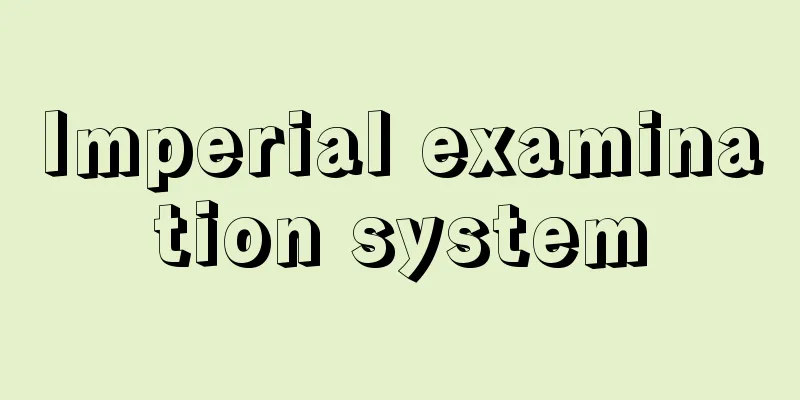Imperial examination system

|
...His first tasks were to consolidate the overall system, such as the establishment of the central government system and the three ministries and six departments system, the unification of the central imperial guard system into the 12 guards system (later expanding from 14 to 16 guards), strengthening the local military governments directly connected to it and returning military power to the central government, reorganizing the Ritsuryo legal system (the Kaihuang Ritsuryo Code, especially the Ritsuryo Code, confirmed the abolition of corporal punishment), and building the capital Daxingcheng (Chang'an Castle of the Tang Dynasty).In addition, he instituted the imperial examination system, which would continue until the end of the Qing Dynasty, as a method of promoting officials, replacing the nine-rank system of officials (the nine-rank system of middle-ranking officials) that had been maintained throughout the Wei, Jin, and Northern and Southern Dynasties periods. He then turned his attention to local government reform, taking a sharp look at the prefecture, county, and province system, which had grown large and complicated during the long period of division and had become an obstacle to centralization. He began by abolishing the provinces and simplifying the system to the prefecture and province system, and then he abolished the conscription system (local appointment system) for local officials and adopted a central appointment system, as well as instituting strict regulations regarding the length of service and service of local officials. *Some of the terminology used in reference to the "Imperial Examination System" is listed below. Source | Heibonsha World Encyclopedia 2nd Edition | Information |
|
…その最初に手がけたのは,中央官制の整備と三省六部制の確立,中央禁軍組織を十二衛府制へ一本化(のちに十四衛府から十六衛府へ拡大)およびそれに直結する地方軍府の充実と軍事権の中央への回収,律令法体系の整序(開皇律令,とくに律では肉刑廃止が確定),首都大興城(唐の長安城)の造営,といった全体にわたる体制固めの仕事であった。あわせて,官吏登用の方法として,清末まで続くことになる科挙制を,魏晋南北朝時代を通じて維持された九品官人法(九品中正制)に代わって発足させた。ついで改革の対象を地方行政の場に求め,長い分裂期のなかで肥大複雑化して中央集権をはばんでいた州郡県制に鋭いメスを入れ,郡を廃止して州県制へ機構を簡素化することを皮切りに,地方官に対する辟召(へきしよう)制(現地任用制)を廃止して中央任命制の採用,地方官の在職年限や服務に関する厳格な規定の制定などを一挙に実現させた。… ※「科挙制」について言及している用語解説の一部を掲載しています。 出典|株式会社平凡社世界大百科事典 第2版について | 情報 |
Recommend
Volksgesang
...A term and concept that originated in Europe, ...
Teruko Onuki
1960- A sports journalist from the late Showa to ...
Accomplice - Kyohan
Two or more people working together to commit a c...
peinture de genre (English spelling)
…In English, it is called genre painting, in Fren...
Yaroumushi - Yaroumushi
Actor Review Record (Yaro Hyoban-ki). Author unkno...
Matto [city] - Matto
An old city in southern Ishikawa Prefecture. Estab...
Bánság (English spelling) Bansag
...Historically, it referred to a rectangular are...
Osunapal - Osunapal
…Legendary Assyrian king. He is sometimes identif...
KPÖ (English spelling) KPO
...The position of party leader passed from Scher...
Bacteremia - Bacteremia
This is a condition in which there is a bacterial ...
Dirty hydrogen bomb - Dirty hydrogen bomb
… [3F Bomb] A weapon that has 238 U around a hydr...
Kirifuri Falls - Kirifuri Falls
Located in northwest Tochigi Prefecture, the Itana...
Seng Lang (English spelling)
A Buddhist monk from the Southern Dynasties of Chi...
Rajahmundri (English spelling)
…a river in the central part of the Indian penins...
intercumulus liquid
…This is the result of crystals that have crystal...









